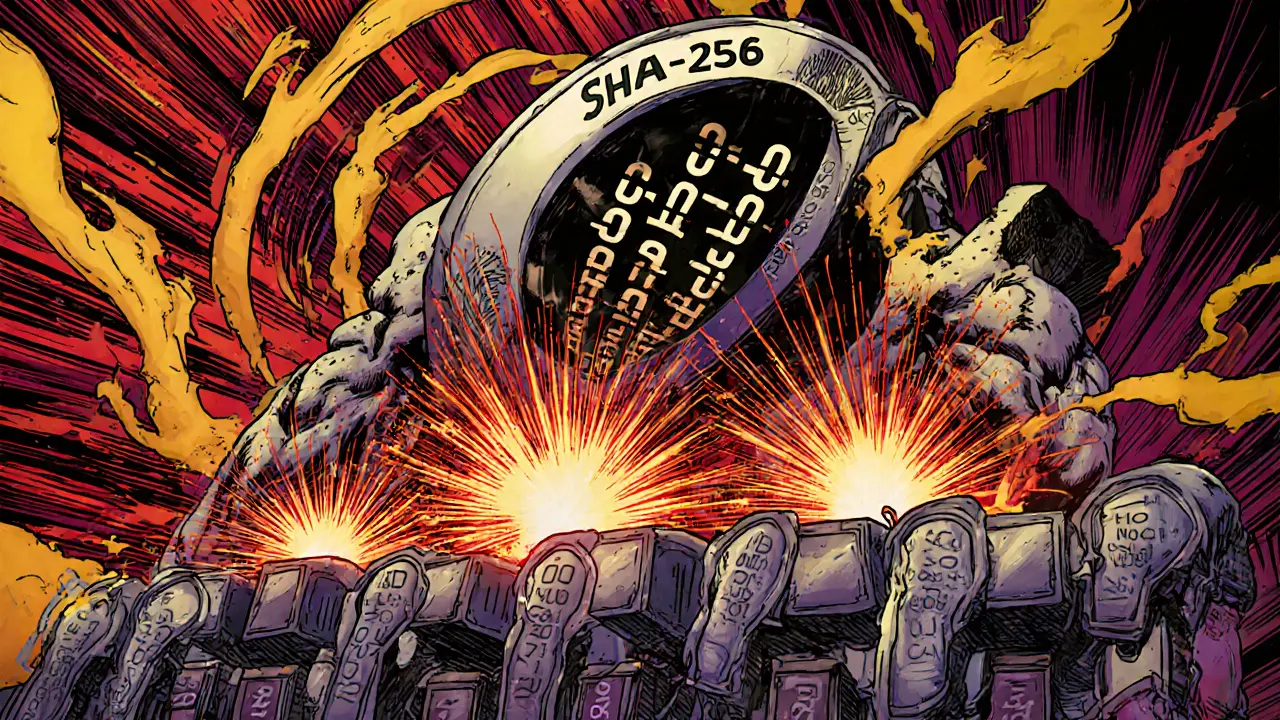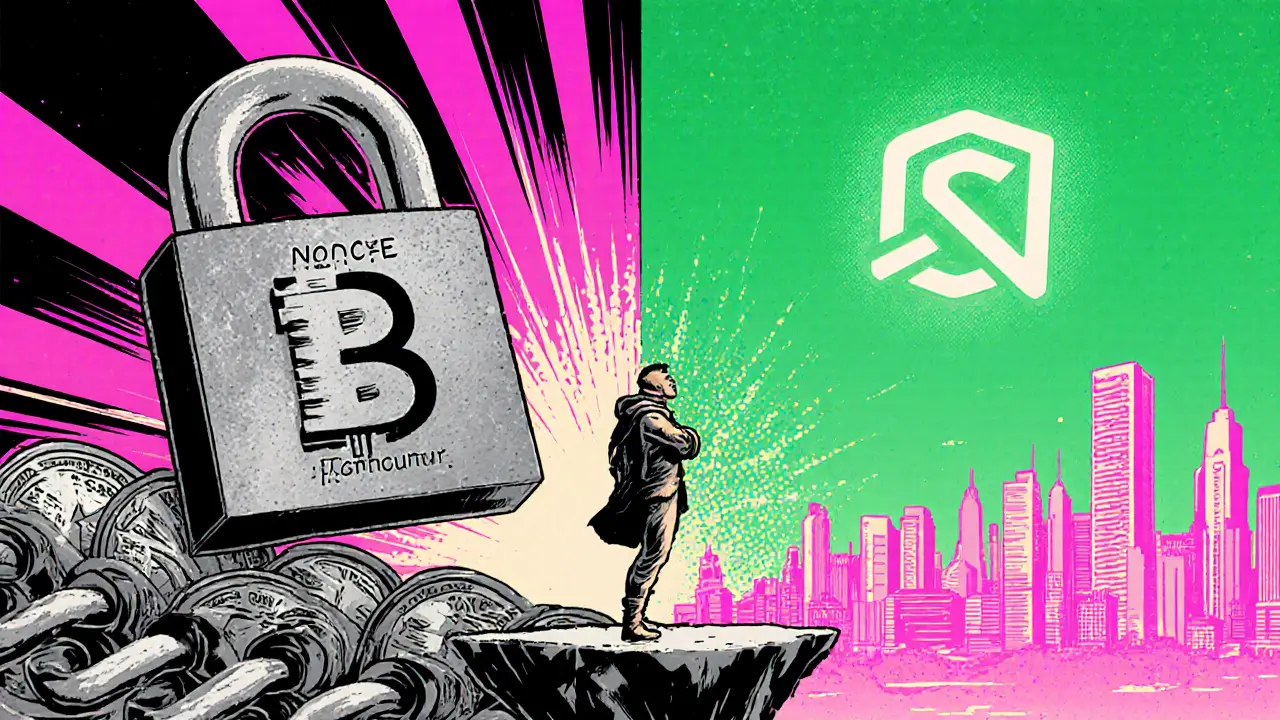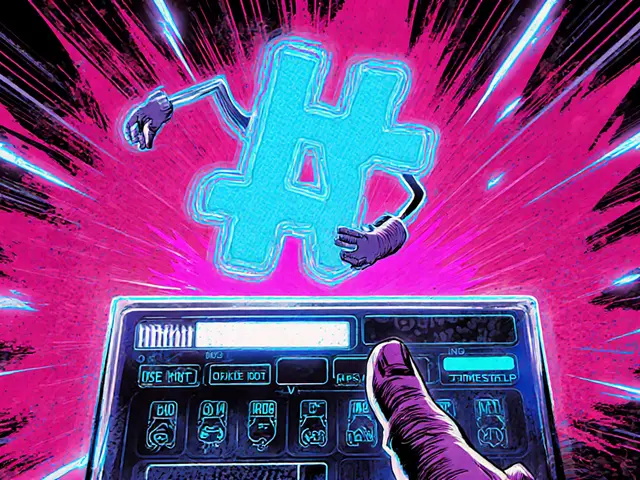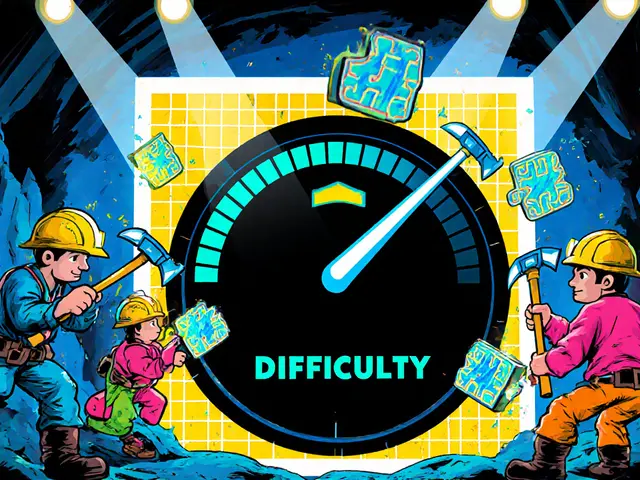Blockchain Nonce Simulator
Resulting Block Hash:
How This Works
This simulator demonstrates how a single nonce value changes the entire block hash in a blockchain. The SHA-256 hash function takes the block header (including the nonce) and produces a 256-bit output. Even a small change in the nonce leads to a completely different hash.
Nonce Range: 32-bit nonce allows up to 4,294,967,295 unique values per block attempt.
Nonce Range Info
Bitcoin uses a 32-bit nonce, which provides approximately 4.3 billion possible values per block.
If a miner tries all possible nonce values without success, they must modify another field in the block header, such as the timestamp.
Hash Difficulty Target
As of 2025, Bitcoin requires approximately 19 leading zeros in the block hash to be considered valid.
This makes finding a valid hash extremely difficult - about 1 in 70 trillion chance per nonce guess.
When you hear the term nonce is a randomly generated number used once in cryptographic operations, especially in blockchain mining, you might wonder why a single number matters so much. In reality, the nonce is the secret ingredient that turns a boring block of transactions into a competitive lottery ticket for miners.
Definition and purpose of a nonce
A nonce-short for “number used once”-acts as a variable that miners tweak until the block’s hash meets the network’s difficulty target. Because the hash function (SHA‑256 for Bitcoin) is deterministic, changing just the nonce changes the output completely, giving miners a way to keep trying new possibilities without altering the actual transaction data.
Proof of Work and why the nonce matters
Proof of Work is a consensus mechanism that requires participants to solve a computational puzzle before adding a new block relies on the nonce as the puzzle’s core. The network sets a difficulty level that translates into a required number of leading zeros in the block’s hash. Miners repeatedly feed the block header-including the nonce-into the SHA‑256 algorithm, hoping one guess will produce a hash low enough to satisfy the rule.
Nonce in the block header
The block header packs all the data a miner needs: previous block hash, Merkle root, timestamp, version, difficulty target, and the nonce itself. In Bitcoin, the nonce field is a 32‑bit integer, giving roughly 4.3billion possible values per round of attempts. If a miner exhausts that range without success, they can adjust other mutable fields (like the timestamp) or start a new block.
How mining works: the trial‑and‑error loop
Every mining attempt follows the same steps:
- Collect pending transactions and build a Merkle tree.
- Construct the block header with the current nonce.
- SHA‑256 is a cryptographic hash function that produces a 256‑bit output from any input data processes the header.
- Check whether the resulting hash starts with the required number of zeros.
- If not, increment the nonce and repeat.
Specialized hardware called ASIC Application‑Specific Integrated Circuit miners are built to compute billions of SHA‑256 hashes per second performs these iterations at terahash speeds, allowing miners to explore millions of nonce values each second.

Difficulty, hash rate, and the odds of success
The network’s difficulty adjusts every 2,016 blocks to keep average block time around 10 minutes determines how many leading zeros a valid hash must have. As of 2025, Bitcoin’s difficulty requires roughly 19 leading zeros, meaning a miner’s chance of hitting a valid hash is about 1 in 70trillion per nonce guess.
The global hash rate measures the total computational power dedicated to mining, expressed in hashes per second has climbed past 400exahashes per second, translating to an astronomical amount of work being done every second. This massive hash rate guarantees security, but it also means that a single nonce guess is virtually guaranteed to fail-hence the need for billions of attempts.
Nonce usage beyond Bitcoin
While Bitcoin popularized nonce‑based PoW, many other coins follow similar patterns. Litecoin uses a faster Scrypt hash function but still relies on a nonce field for mining targets a 2‑minute block time, and its nonce field is also 32bits. Ethereum originally used a nonce in its PoW implementation, but the network switched to Proof of Stake in 2022, eliminating mining entirely. This shift shows that the nonce is not a universal requirement-only PoW‑based chains need it.
Optimizing nonce handling
Experienced miners tweak more than just the raw number. Mining pools distribute nonce ranges to avoid overlap, reducing wasted effort known as “nonce collision.” Some software, like CGMiner and BFGMiner, implements smart nonce stepping algorithms that skip values unlikely to produce a different hash due to internal SHA‑256 quirks, gaining a modest 2‑5% boost in efficiency.
When the difficulty adjusts upward, miners often see a temporary dip in profitability because the same hardware must try more nonce values to find a valid block. Monitoring difficulty changes-roughly every two weeks-helps miners decide whether to upgrade ASICs, join a larger pool, or pause operations.
Future outlook: will nonces survive?
Research is already exploring alternatives that keep security while lowering energy use. Hybrid models combine PoW (with a nonce) and Proof of Stake, letting the network fall back on a nonce‑based lottery only when stake participation drops. Quantum‑resistant hash functions are also under evaluation; if they replace SHA‑256, the nonce will likely remain but the underlying math will change.
Environmental concerns are pushing new projects to skip PoW entirely, but Bitcoin’s massive existing infrastructure and conservative governance mean its nonce‑based system will probably persist for the foreseeable future.
Quick reference checklist
- Nonce: 32‑bit random number used once per mining attempt.
- Block header fields: previous hash, Merkle root, timestamp, version, difficulty, nonce.
- Target hash: must contain a set number of leading zeros (≈19 for Bitcoin in 2025).
- Typical hardware: ASIC miners delivering terahashes per second.
- Difficulty adjustment: every 2,016 blocks (~2 weeks).
- Key metric: network hash rate (≈400EH/s for Bitcoin).
- Optimization tip: join a pool that distributes nonce ranges efficiently.
| Coin | Hash Function | Nonce Size | Block Time | PoW Status (2025) |
|---|---|---|---|---|
| Bitcoin | SHA‑256 | 32bits | 10min | Active |
| Litecoin | Scrypt | 32bits | 2.5min | Active |
| Ethereum (pre‑Merge) | Ethash | 64bits (combined with mix‑hash) | 12‑14sec | Switched to PoS |

Frequently Asked Questions
Why does Bitcoin need a nonce?
The nonce gives miners a controllable variable to change the block’s hash without altering transaction data, turning the mining process into a repeatable trial‑and‑error puzzle.
Can I reuse a nonce in another block?
No. Each nonce is valid only for the specific block header it was combined with. Changing any other field (e.g., timestamp) requires a new nonce.
What happens if all 4.3billion nonce values are tried without success?
Miners modify another mutable field-usually the timestamp-or start a brand‑new block, resetting the nonce range.
Do all cryptocurrencies use a 32‑bit nonce?
Most PoW chains adopt a 32‑bit nonce for simplicity, but some, like early Ethereum, used larger combined values (e.g., 64‑bit mix‑hash) to expand the search space.
Is the nonce the same as a transaction ID?
No. A transaction ID is the hash of an individual transaction, while the nonce is a separate field in the block header used solely for mining.



Patrick MANCLIÈRE
June 11, 2025 AT 05:20So basically the nonce is the little number miners keep tweaking until the block hash hits the difficulty target – think of it like a lottery ticket that changes every time you pick a new number.
Brooklyn O'Neill
June 12, 2025 AT 23:00Great explanation, Patrick! Just remember newcomers that the nonce doesn’t affect the transactions themselves; it’s purely a tool for the proof‑of‑work puzzle.
Carthach Ó Maonaigh
June 15, 2025 AT 01:00Yo, if you think a nonce is just some random number, you’re missing the whole grind – miners are basically screaming at their ASICs, trying every damn combo until the hash looks like a unicorn.
Marie-Pier Horth
June 17, 2025 AT 08:33Ah, the nonce – the philosopher’s stone of blockchain alchemy, transmuting mundane data into cryptographic gold, a true testament to humanity’s endless quest for order amidst chaos.
Gregg Woodhouse
June 19, 2025 AT 18:53lol carthach, u think miners just press a button? they’re like, "hey, maybe this number works?" and then… nope, try again. u feel me?
F Yong
June 21, 2025 AT 15:20Honestly, the whole nonce drama is just another layer of obfuscation to keep the masses from seeing how vulnerable the system really is – they’d never let us know.
Sara Jane Breault
June 23, 2025 AT 14:33Nice breakdown! If you’re just getting started, try the simulator and play around with the nonce – it’s the easiest way to see how each tiny change flips the whole hash.
Andrew McDonald
June 25, 2025 AT 16:33Alright folks, let’s get real: the nonce is the only thing that keeps mining from being a boring repeat‑off‑the‑same‑old‑song. Without it, the whole PoW thing collapses.
Latoya Jackman
June 27, 2025 AT 10:13I appreciate the clarity here. Respectful reminder: always double‑check your nonce range before assuming a block is unsolvable.
Rachel Kasdin
June 28, 2025 AT 22:20Yo, why bother with a 32‑bit nonce when you can just crank up the hash rate? #JustSaying
Nilesh Parghi
June 30, 2025 AT 07:40Think of the nonce as a friendly puzzle piece – it fits just right when the network’s difficulty whispers its secret.
C Brown
July 1, 2025 AT 22:33Sure, the nonce is “important,” but have you considered that ASICs are just glorified number‑crunchers? It’s all hype.
Noel Lees
July 3, 2025 AT 19:00Keep your chin up, miners! Every failed nonce brings you one step closer to that sweet block reward :)
Adeoye Emmanuel
July 5, 2025 AT 21:00When we contemplate the nonce, we must first acknowledge its humble origin as a mere counter, yet its impact reverberates through the very fabric of decentralized consensus. The nonce, a 32‑bit integer, provides roughly 4.3 billion permutations for each mining attempt, a staggering combinatorial space that fuels the proof‑of‑work mechanism. As miners iterate through this space, each incremental change produces a completely different SHA‑256 output, embodying the avalanche effect inherent to cryptographic hashes. This deterministic chaos ensures that no two attempts yield the same hash, preserving the integrity of the blockchain. Moreover, the nonce operates alongside other mutable header fields-most notably the timestamp-allowing miners to reset the search space when exhaustion occurs. The difficulty adjustment, occurring every 2,016 blocks, calibrates the target number of leading zeros, thereby dictating the odds of any single nonce succeeding; currently about one in 70 trillion. Consequently, the network’s colossal hash rate, now surpassing 400 EH/s, is a direct consequence of the relentless pursuit of valid nonces across the globe. From a philosophical standpoint, the nonce embodies the tension between randomness and order, a digital echo of the age‑old debate between fate and free will. Technological advances, such as smarter nonce stepping algorithms, aim to prune unlikely candidates, shaving a modest percent off the massive computational demand. Yet, the core principle remains unchanged: a simple number, used once, holds the power to secure an entire monetary system. Looking ahead, proposals for hybrid consensus models still rely on a nonce‑like construct when PoW fallback becomes necessary, reinforcing its timeless relevance. In sum, while the nonce may appear trivial, it is the keystone that upholds the edifice of modern blockchain security.
Raphael Tomasetti
July 7, 2025 AT 14:40From a protocol engineering perspective, the nonce is simply a field in the block header that must be iterated over to meet the target threshold defined by the difficulty bits.
Jenny Simpson
July 9, 2025 AT 02:46Honestly, all this nonce talk is just glorified luck – miners are basically gambling with numbers, hoping the universe aligns.
Sabrina Qureshi
July 10, 2025 AT 12:06Wow!!! This article is so helpful!!! I feel like I finally understand the secret sauce behind Bitcoin’s security!!!
Rahul Dixit
July 12, 2025 AT 03:00They don’t tell you that the nonce is actually a backdoor for the elite to control the network – open your eyes.
CJ Williams
July 13, 2025 AT 20:40Great insight, Adeoye! 👍 The way you broke down the nonce’s role in both security and future research really helps newcomers grasp the concept.
mukund gakhreja
July 15, 2025 AT 08:46Look, even though the nonce is just a number, the way miners exploit every micro‑optimization is absurdly impressive – love the sarcasm, though.
Ron Hunsberger
July 16, 2025 AT 23:40The nonce is the basic building block of PoW, simple yet essential.
Lana Idalia
July 18, 2025 AT 11:46Sure thing, but don’t forget that if you misuse the nonce you’ll just waste a ton of electricity.
Henry Mitchell IV
July 19, 2025 AT 21:06Nice post! :)
Kamva Ndamase
July 21, 2025 AT 09:13Exactly, the nonce is the heartbeat of mining – without it, the whole system would just sit there, dead.
Janelle Hansford
July 23, 2025 AT 02:53Awesome rundown, especially the part about difficulty adjustments – really helps demystify the process.
Ciaran Byrne
July 24, 2025 AT 20:33Thanks for the clear explanation.